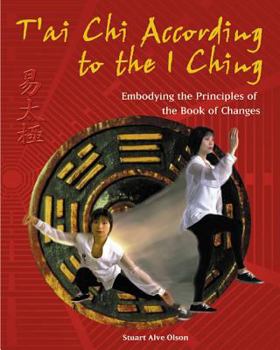T'Ai CHI According to the I Ching: Embodying the Principles of the Book of Changes
Select Format
Select Condition 
Book Overview
- Reveals the close relationship between the eight basic postures of T'ai Chi and the hexagrams of the I Ching. - As handed down in the teachings of the Yellow Emperor and Chang San-Feng. - Explains... This description may be from another edition of this product.
Format:Paperback
Language:English
ISBN:0892819448
ISBN13:9780892819447
Release Date:September 2001
Publisher:Inner Traditions International
Length:240 Pages
Weight:1.28 lbs.
Dimensions:0.7" x 8.1" x 10.0"
Customer Reviews
2 ratings
Very detailed
Published by Thriftbooks.com User , 18 years ago
Very detailed discussion of tai chi concepts, linking the techniques explicitly to the 8 trigrams, the five activities and five elements. The book is chock full of diagrams and illustrations that show these relationships, which makes it good as a reference, as you'll find few other books that lay it all out like this one does. Also discussions and presentations of the pre-heaven 16-movement form for both yin and yang parts, and the 64 move post-heaven form, the 8 hands, and the 8 stances as well. There's a huge amount of detail here also, which is bound to make it a little intimidating to some people, but overall a very detailed book although perhaps more than most people will want to wade through to gain an understanding of these concepts, since most tai chi practitioners are probably more interested in practical applications rather than an advanced knowledge of taoist theory. But at least some knowledge of that is necessary to become a truly advanced practitioner, and this book serves very well in that regard. By the way, a little history here and also by way of comparing tai chi with kung fu. Tai chi was developed in the vicinity of the Wu Dan mountain, and is one of the three internal arts, along with Hsing I and Ba Gua. According to the history, tai chi was developed when a master (can't recall his name right now) back in the 13th took the Twelve Canons of Chinese Boxing, a famous martial arts book, added the great Da Mo's internal principles and modified the postures, and created the first tai chi movements. In the beginning there were only a half a dozen movements, but these were later expanded. Although tai chi is known as a soft, internal art, it's not correct that it can't be hard. Tai chi is both hard and soft, but the balance between the two is different. In kung fu or Shaolin, the hardness and softness run the full gamut or spectrum. There are movements which are extremely soft and there are others that are very hard with lots of power and strength. In tai chi, however, the two principles of yin yang come into play, which means that the hard and the soft are always balanced, and there is never an excess of either, so you don't get the extremes like you do in kung fu. However, tai chi is capable of hitting very hard when it wants. My masters would prefer to use the other person's strength against them, but when pressed, they had no problem with just hitting you hard, either, and they could hit just as hard as my karate and kung fu masters. :-) Another point to keep in mind is that there is considerable overlap between kung fu and tai chi, as both have internal training. It's just that in tai chi, they start with the internal and work outword to the external, and kung fu starts with the external and works inward. In that sense, their methods are opposite sides of the same coin. This is because kung fu's internal chi gung methods come from Da Mo (or Daruma or Bodidharma, as he's sometimes called), rather than from the master or mas
Almost a home run
Published by Thriftbooks.com User , 20 years ago
This book is difficult to review because if you are like me you love it when technical manuals of this kind are presented. This is a great effort and as always Mr. Olson does a great job, but I think it would have been a home run if the focus was kept tighter. I think this should have been 2 books and each might have been made even more to the point in clarity. It will be in my library though along with a simpler? version by Da Lui.





